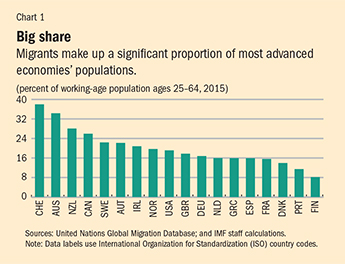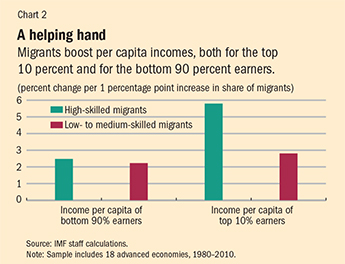A Spoonful of Sugar
Finance & Development, December 2016, Vol. 53, No. 4
Florence Jaumotte, Ksenia Koloskova, and Sweta Saxena

High- and low-skill immigration both raise incomes and confer broad benefits on advanced economies
The legend: Around the eighth century A.D., Parsis fleeing Iran after the Arab conquest sought refuge in India. When they arrived the local ruler presented them with a cup of milk filled to the brim, to signify that the land couldn’t possibly accommodate more people. The Parsi leader responded by slipping sugar into the milk to show that strangers could enrich the local community without displacing it. They would dissolve into society like sugar into milk, sweetening but not unsettling it (NPR).

Today’s reality: Migration has become a hot-button issue around the world, not least because of the recent surge in refugees. While newspapers are filled with photos of people fleeing their homelands, a large and growing population of migrants is already living in advanced economies (see Chart 1). Adult migrants make up 15 to 20 percent of the working-age population in many advanced economies, and 25 percent or more in some Anglo-Saxon countries, such as Australia, Canada, and New Zealand. They accounted for half the growth in the working-age population of advanced economies between 1990 and 2015, and the United Nations projects that without further migration, aging will further reduce the share of workers in most of those economies over the next decade.
After so many centuries, the question remains, do migrants sweeten the milk or unsettle it?
Costs versus benefits
Public sentiment in advanced economies is much more negative when it comes to immigration than to trade for two main reasons. First, people often perceive migration as a zero-sum game: they fear losing their job or having to accept lower wages. Most studies, however, find that the impact of migration on average wages or employment of native workers is very limited (for a survey, see Peri, 2014). Some studies, though, find that the wages of low-skilled workers do suffer (for example, Borjas, 2003; Card, 2001). Second, natives fear losing their cultural identity when migrants find it difficult to integrate. Surveys show that in Europe personal concerns over the compositional effects of migration—such as language and culture—matter much more to people than economic concerns such as jobs (Card, Dustmann, and Preston, 2012). Linguistic and cultural obstacles, combined with failure to recognize foreign education and experience—and in some cases implicit discrimination—can prevent the integration of migrants. Thus, there is no denying that in the short term there can be negative effects associated with migration—and sometimes the short term can be quite long.
In a new study, however, we show that migrants can bring significant long-term benefits to host countries through higher incomes per person and thus higher standards of living. Hence, it may be worth shouldering the short-term costs of helping migrants integrate into the labor market and society.
The standard argument in favor of immigration is an increase in the share of working-age people in the total population, because migrants tend to be relatively younger than natives, especially in host countries where the population is aging. Therefore, there is more income to be shared among the population, including through taxes and redistribution policies. This is one channel through which migration increases income per person, but it is not the most powerful one.
● The second channel is migrants’ impact on output per worker, or what we call labor productivity, which is affected by immigration in various ways.
● First, immigration can lower labor productivity, at least initially, as the entry of new labor reduces the available physical capital per worker. The evidence, however, suggests that over time the stock of capital adjusts to the expanded labor force through more investment.
● Second, there is a perception that migrants are on average less educated than natives, which could also lower labor productivity. In fact, migrants are increasingly high and medium skilled, and in many countries, the share of high-skilled workers is higher among migrants than among natives.
● Finally, studies have shown that both high- and low-skilled migrants can have positive effects on aggregate productivity through various channels. For instance, high-skilled migrants increase innovation and boost the productivity of high-skilled native workers. But lower-skilled migrants can also increase the overall efficiency of the economy. They can do so by taking on jobs for which natives are in short supply, for instance in agriculture and nursing (complementarity of skills). Their presence can also encourage natives to add to their own education and take jobs that require more complex skills (upskilling), especially those involving language and communication, where they have a comparative advantage (for example, D’Amuri and Peri, 2014). A good example of complementarity is the “nanny” effect: when low-skilled migrants increase the availability of household and child care services, they enable native women, especially those with higher skills, to participate more fully in the labor market (for example, Cortés and Tessada, 2011).
The question, though, is whether these effects are large enough to have a noticeable impact on the total productivity of the economy. Two broad cross-country studies have found that immigration has a large effect on income per capita and productivity (Ortega and Peri, 2014; Alesina, Harnoss, and Rapoport, 2016). We looked at the same question, focusing exclusively on advanced economies, where the number of migrants has been large relative to the native population and immigration is controversial. We found some key long-term effects of immigration on host advanced economies:
● In the long run, migrants help raise per capita income levels significantly, mostly through increased labor productivity.
● In addition to the benefits associated with highly educated migrants’ productivity, there are similar benefits from low-skill migration, albeit via different channels.
● The gains from immigration are broadly shared across the population.
New evidence
To arrive at these conclusions, we use a new database that provides the number of migrants by origin and education level for 18 advanced economies at five-year intervals during 1980–2010. Econometric techniques allow us to examine the impact of the stock of migrants (overall and by education) on GDP per capita and labor productivity, controlling for other determinants of host countries’ income levels, such as the level of technology, the education and age structure of the population, trade openness, and country and time fixed effects (a proxy for country- and time-specific determinants of income per person).
Studying the impact of immigration at the macro level presents challenges. It is difficult to disentangle immigration’s direct effect on income per capita from possible reverse influences of income per capita on immigration—for instance, the fact that high incomes in advanced economies attract migrants or that high-income countries may control immigration flows more tightly. To address this issue, we construct a proxy for migration (an “instrumental variable,” in econometric jargon) based solely on factors independent of host economies’ income level. These include “push” factors from the source economies—for example, poor economic and political conditions—and costs of migration as determined by geographic and cultural distance between host and source countries.
Using this approach, we find that migrants do significantly increase income per capita in advanced economies, mostly by raising labor productivity. Although lower than in previous estimates, the effect still tends to have a significant impact on the economy: a 1 percentage point increase in the share of migrants in the adult population can raise GDP per capita by up to 2 percent over the long term. Moreover, both high- and lower-skilled migrants appear to increase labor productivity. High-skilled workers bring diverse talent and expertise. The contribution of those with lower skills is likely to rise the larger the complementarity with natives’ skills. For instance, we find that when more low-skilled people enter a country more native women tend to enter the labor force, presumably because they are able to get household and child care help.
Some caveats are in order. On the one hand, the estimated effect is an average across countries, and for a particular country the effect could be sensitive to a number of factors, such as the type of migration (economic migrants versus refugees), the organization of the labor market, and the extent of complementarity between migrants and natives. On the other hand, the effect could be negative or smaller in the short run as the economy and capital stock adjust to changes in the number of working migrants.
An important question, though, beyond the average effect on income per person in a country, is how these gains are distributed across the population. If all the gains are captured by capital owners and companies’ top executives, the broad population might not benefit and could actually be worse off.

However, our analysis suggests that the gains from immigration are broadly shared—even though workers in some occupations could be hurt initially (see Chart 2). Migration increases the average income per capita of both the bottom 90 percent and the top 10 percent of earners, even though high-skill migration benefits top earners more—perhaps because of stronger synergy between migrants and natives with high skills. Moreover, there is no evidence that immigration exacerbates inequality within the bottom 90 percent of earners.
A sweeter cup
Migration entails initial costs: integration can be slow, and some native workers may suffer. But there are long-term and economy-wide benefits, which are broadly shared. The key to harnessing these gains is to ensure the labor market integration of migrants (Aiyar and others, 2016).
A number of policies can help immigrants, including language training and job search support; recognition of their education and work experience; and easing the way to entrepreneurship. At the same time, mitigating policies are needed to facilitate the adjustment of natives. These include, for example, helping natives upgrade their skills or reducing possible congestion in the use of public services such as health or education.
Japan is a good example of a country where immigration has been historically quite low, due in part to language and cultural barriers. Temporary immigration has picked up recently in response to shortages of labor as the working-age population falls, with companies providing training to immigrants.
Eventually, economic reality can overcome cultural resistance to migration, and a spoonful of sugar can sweeten the milk. ■
Florence Jaumotte, Ksenia Koloskova, and Sweta Saxena are, respectively, Senior Economist, Economist, and Senior Economist in the IMF’s Research Department.
This article is based on the authors’ 2016 IMF Spillover Note, “Impact of Migration on Income Levels in Advanced Economies.
References
Aiyar, Shekhar, Bergljot Barkbu, Nicoletta Batini, Helge Berger, Enrica Detragiache, Allan Dizioli, Christian Ebeke, Huidan Lin, Linda Kaltani, Sebastian Sosa, Antonio Spilimbergo, and Petia Topalova, 2016, The Refugee Surge in Europe: Economic Challenges, IMF Staff Discussion Note 16/02 (Washington: International Monetary Fund).
Alesina, Alberto, Johann Harnoss, and Hillel Rapoport, 2016, “Birthplace Diversity and Economic Prosperity, Journal of Economic Growth, Vol. 21, No. 2, pp. 101–38.
Borjas, George J., 2003, “The Labor Demand Curve Is Downward Sloping: Reexamining the Impact of Immigration on the Labor Market,” Quarterly Journal of Economics, Vol. 118, No. 4, pp. 1335–74.
Card, David, 2001, “Immigrant Inflows, Native Outflows, and the Local Market Impacts of Higher Immigration,” Journal of Labor Economics, Vol. 19, No. 1, pp. 22–64.
———, Christian Dustmann, and Ian Preston, 2012, “Immigration, Wages, and Compositional Amenities,” Journal of the European Economic Association, Vol. 10, No. 1, pp. 78–119.
Cortés, Patricia, and José Tessada, 2011, “Low-Skilled Immigration and the Labor Supply of Highly Skilled Women,” American Economic Journal: Applied Economics, Vol. 3, No. 3, pp. 88–123.
D’Amuri, Francesco, and Giovanni Peri, 2014, “Immigration, Jobs, and Employment Protection: Evidence from Europe before and during the Great Recession,” Journal of the European Economic Association, Vol. 12, No. 2, pp. 432–64.
Ortega, Francesc, and Giovanni Peri, 2014, “Openness and Income: The Role of Trade and Migration,” Journal of International Economics, Vol. 92, No. 2, pp. 231–51.
Peri, Giovanni, 2014, “Do Immigrant Workers Depress the Wages of Native Workers?” IZA World of Labor, 2014:42.
Opinions expressed in articles and other materials are those of the authors; they do not necessarily reflect IMF policy.


